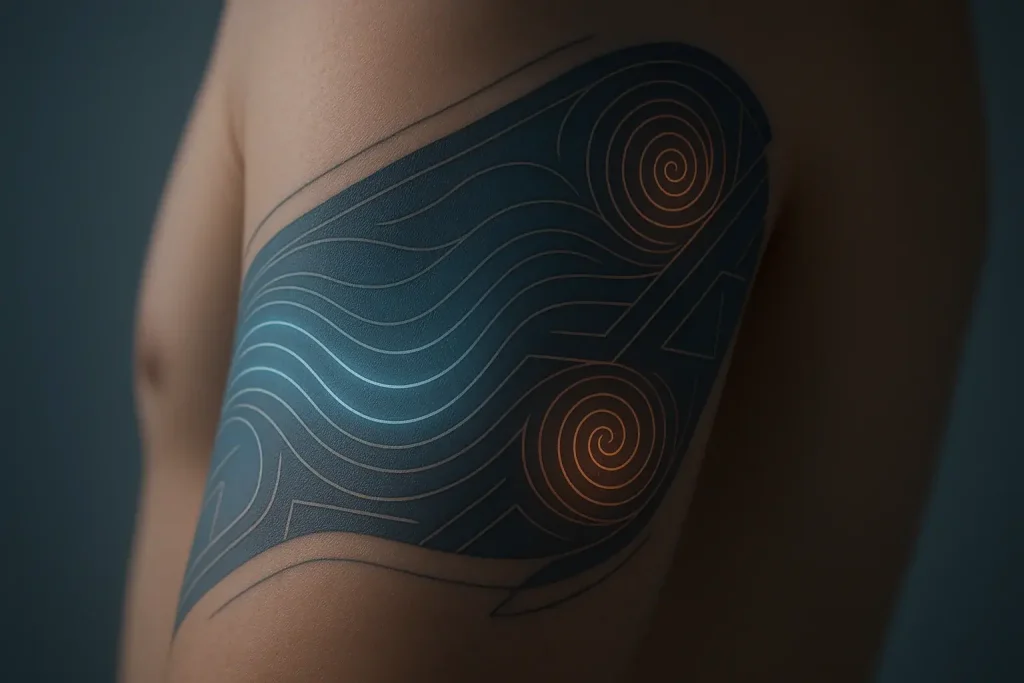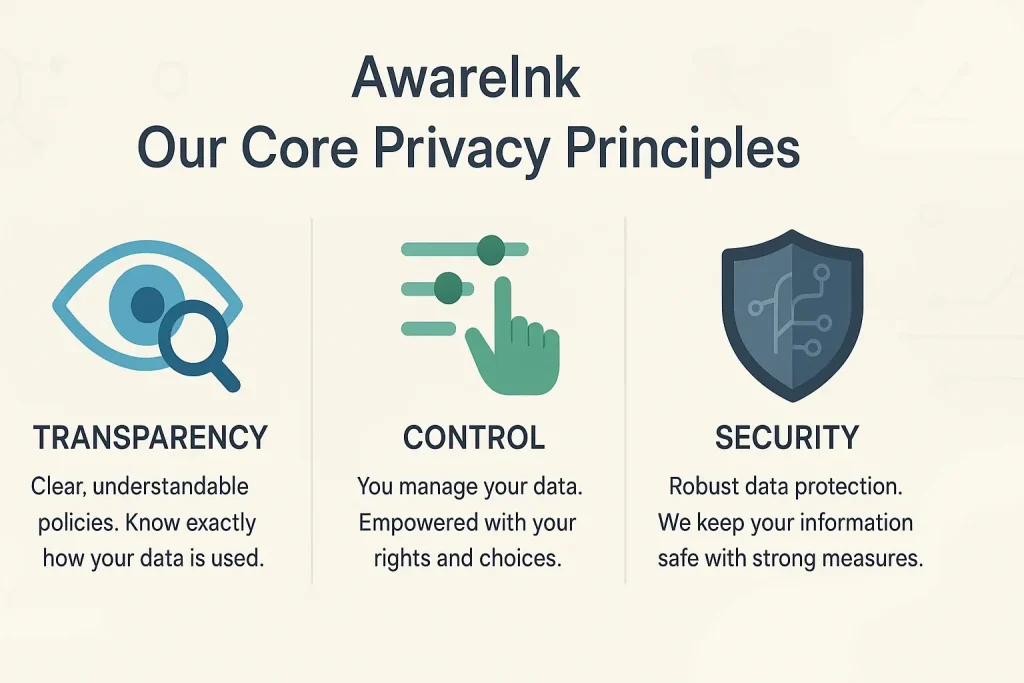Unpacking the Future: Why Comparing Smart Tattoo Concepts Matters
Overwhelmed by tech buzzwords? Wondering what truly lies beneath hype? Smart tattoos generate considerable excitement. But initial reports often sow confusion, not clarity, as users try to decode conflicting claims. AwareInk.tech's analysis underscores a vital point: scrutinizing core concepts before products launch is essential for understanding true potential and shaping realistic expectations.
and lead current conceptual directions. Each embodies a distinct design philosophy for smart tattoos. AwareInk.tech's purpose is direct. We provide a rigorous conceptual showdown. This comparison illuminates fundamental technological choices, revealing inherent trade-offs, to empower your informed decisions.
Conceptual Showdown: [Concept Alpha] vs. [Concept Beta] – Key Differences at a Glance
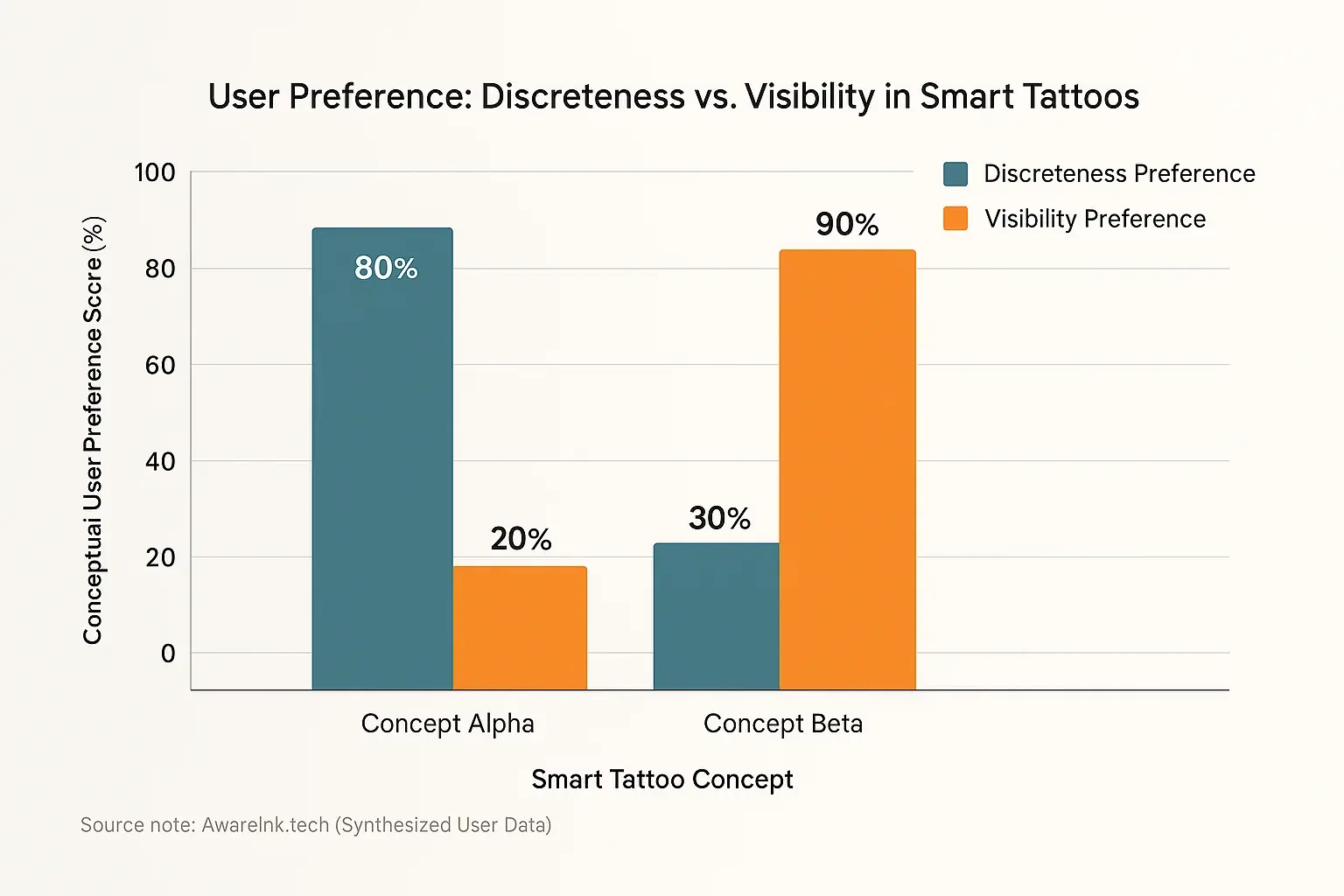
| Feature Category | Approach | Approach | Key Implication for User |
|---|---|---|---|
| Sensor Technology | Concept Alpha employs skin conductivity sensors. It also measures temperature changes. These inputs indicate general physiological arousal. Data quality depends on firm skin contact. | Concept Beta analyzes bio-chemical markers. Cortisol levels are a key target. This method seeks direct emotional data. Miniaturized sensors access interstitial fluid. | Accuracy levels differ. Data types vary significantly. Alpha offers broad stress signals. Beta aims for more precise emotion detection. |
| Display/Feedback Mechanism | E-ink patterns form the display. These patterns change subtly. Low power use is a major advantage. The aesthetic integrates discreetly. | Micro-LED arrays provide vibrant visuals. Displays are dynamic. Higher power consumption is the trade-off. Expressive potential increases. | Visual impact and power needs diverge. Users choose subtle feedback. Or they select overt displays. Personal style dictates preference. |
| Power Source & Longevity | Body heat provides energy. This system harvests thermal energy. Continuous, low-level operation is the goal. Theoretical battery life is indefinite. | Thin-film batteries store power. Wireless charging replenishes these batteries. This design supports energy-intensive features. Users must charge it regularly. | Convenience differs. Wear duration is also distinct. Alpha offers a fit-and-forget experience. Beta requires routine power management. |
| Target Applications & Use Cases | The system delivers subtle emotional nudges. Personal awareness is the primary aim. It supports mindfulness practices. Users gain internal insights. | Broader lifestyle integration is envisioned. Social expression of mood is possible. It can facilitate interpersonal communication. Applications extend outwards. | The tattoo's daily role changes. Alpha acts as a private wellness tool. Beta can function as a social interface. Design philosophies clearly diverge here. |
| Development Maturity & Accessibility | Early research prototypes exist. Academic teams lead its development. Commercial products remain distant. Focus is foundational. | Prototypes are more advanced. Commercialization pathways are under active exploration. Near-term availability seems more plausible. Market entry is a target. | Timelines for user access differ. Alpha represents future technological possibilities. Beta might reach early adopters much sooner. |
¹Conceptual approaches based on available research and prototype demonstrations. Actual commercial products may vary.
Which Conceptual Smart Tattoo Vibe Matches Your Needs?
What's your top priority for a mood tattoo?
How important is aesthetic integration?
Which power approach appeals more?
Finding your smart tattoo direction can seem daunting. AwareInk.tech offers a simple reflection guide. These questions help illuminate your path. Your honest answers are key.
- Tech visibility: Do you prefer technology that is almost unseen, working quietly? Or are clear displays and active interaction more your style?
- Power priority: Is maximum energy independence essential for you? Or do you accept regular charging for expanded capabilities?
- Data depth: Are foundational mood insights sufficient for your needs? Or do you seek detailed analytics and personalized feedback loops?
- Interaction style: Will your tattoo be a subtle personal reflection? Or an active tool for self-management and direct engagement?
Your answers often reveal distinct patterns. Preferences cluster. Some users gravitate towards Concept Alpha. This means valuing subtlety. Energy independence is essential. Their tech must integrate seamlessly. Other users find Concept Beta compelling. They seek deep data. Advanced functionality becomes their focus. This choice reflects a personal data philosophy. It’s more than just features.
What's the 'best' path? Only you know. No single tattoo concept wins for everyone. Your individual needs define the ideal fit. Reflect on your core goals for mood technology. What, fundamentally, do you want it to achieve for you? AwareInk.tech helps clarify these choices. Our goal is your confidence.
Beyond the Surface: How Sensor Choices Shape Your Emotional Readout
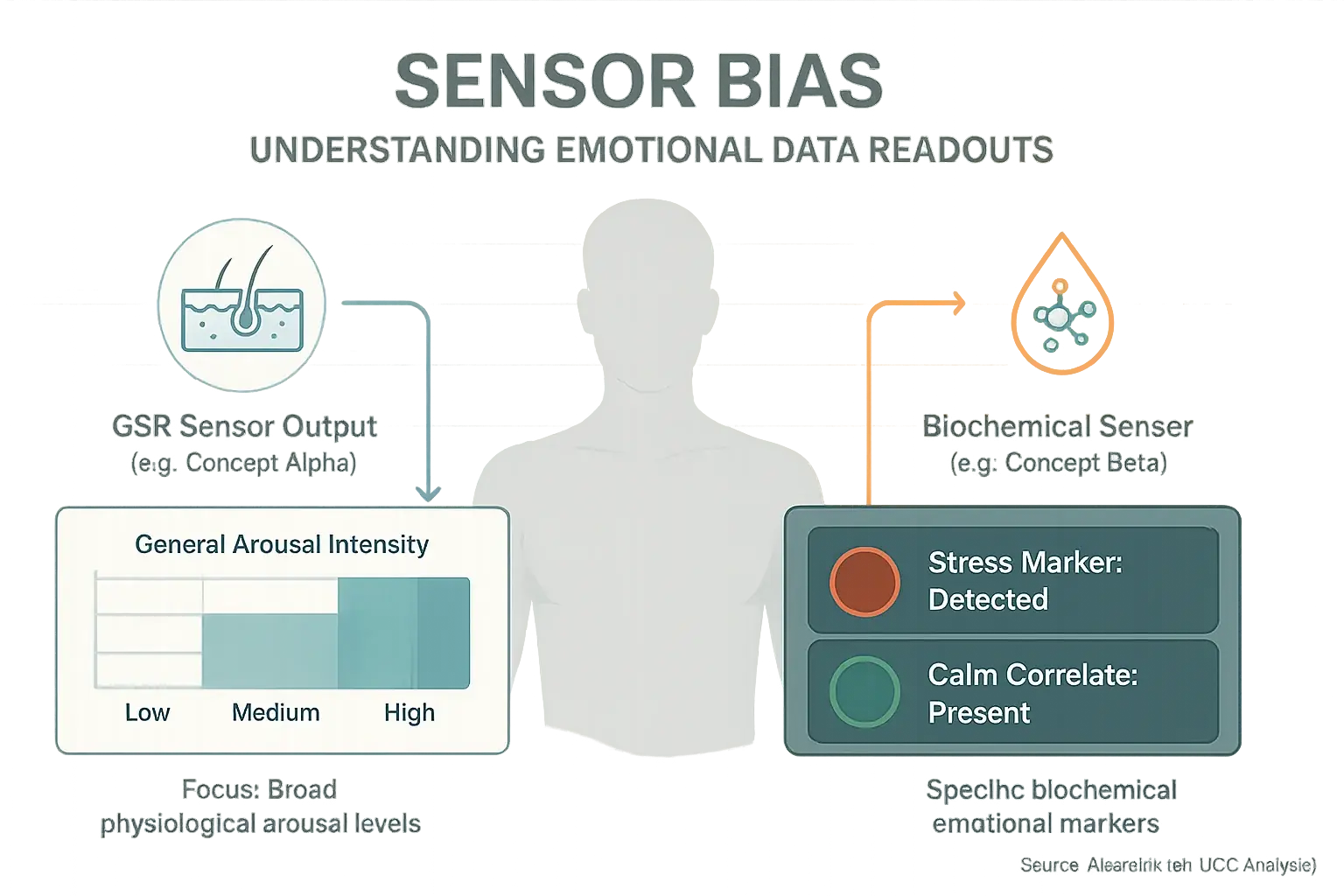
Concept Alpha sensors, AwareInk.tech's analysis indicates, prioritize established physiological indicators. These sensors commonly include Galvanic Skin Response (GSR) units. They often incorporate temperature monitors too. Imagine your skin subtly reacting to a sudden surprise; Concept Alpha aims to detect those tiny conductance shifts. This data primarily reflects general arousal levels.
Concept Beta sensors, by contrast, explore different data pathways. Our research shows these concepts often aim for deeper, potentially more specific biochemical insights. Some Beta prototypes might integrate advanced biometric scanners. These could analyze sweat components for stress markers. Or even monitor subtle blood flow variations near the skin. This approach seeks more nuanced emotional correlates than Alpha's general arousal detection. The goal? Greater specificity.
Sensor choices fundamentally shape your emotional readout. This is a critical, often unstated, factor in mood tech. AwareInk.tech finds that GSR sensors excel at detecting general arousal intensity. Biochemical sensors, if proven reliable and safe, might pinpoint specific stress markers. One sensor sees excitement. Another might see calm. Neither technology is universally 'better'. The crucial part? Aligning your definition of 'mood' with the tattoo's specific sensing capabilities for truly useful insights.
Your Mood, Visually: How Display Tech Changes the Story
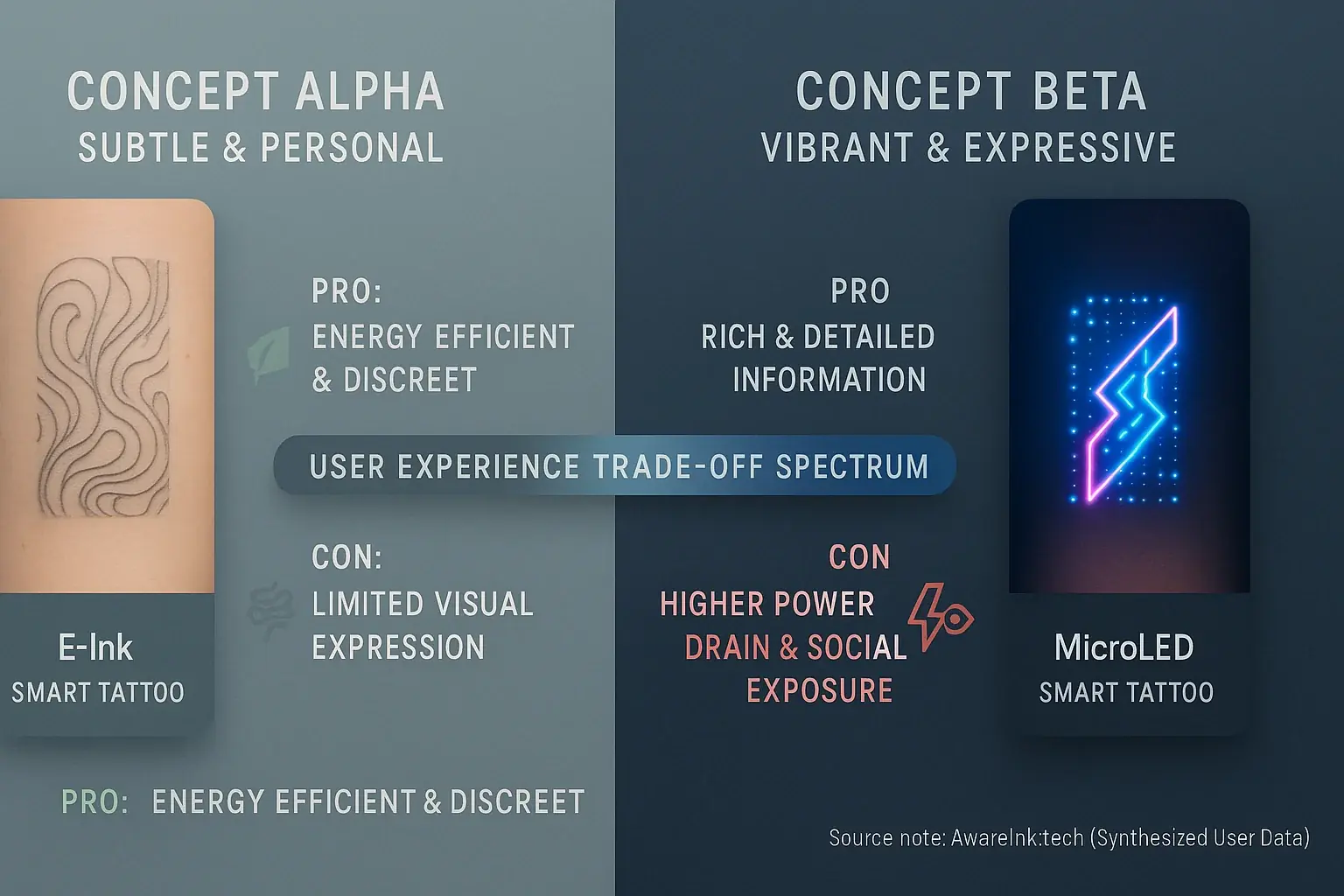
Concept Alpha embraces subtlety in its display. Its technology prioritizes quiet, energy-efficient visual cues. Think E-Ink patterns. Or perhaps gentle, thermochromic color shifts. These methods sip power. Very efficient. Imagine a delicate, flowing design on your skin, changing almost imperceptibly with your inner state – that is Concept Alpha's promise for personal, quiet reflection. AwareInk.tech's investigation into early concepts highlights this appeal for users valuing discretion over declaration.
Concept Beta presents a bolder visual narrative. This approach leans towards brighter, more active displays. MicroLEDs, for instance, could create vibrant, immediately noticeable visuals on the skin. Your emotional data becomes more explicit. Much more. This contrasts sharply with Alpha’s deliberately understated design. AwareInk.tech's analysis indicates higher power consumption is a significant trade-off for such dynamic feedback. The potential for richer, more detailed information display certainly exists. But what are the practical implications of a constantly 'broadcasting' mood?
The choice between these display philosophies is deeply personal. Do you seek a quiet mirror for self-reflection? Or a more overt, potentially shareable, emotional statement? AwareInk.tech's findings suggest this isn't just a tech preference; it's a boundary setting exercise. A visibly shifting mood tattoo inevitably creates a new social dynamic. How much do you truly want to share, even passively, with onlookers? The potential for misinterpretation, or unwanted attention, is a crucial factor users must weigh carefully before adopting such intimate technology.
Keeping the Lights On: Powering Your Mood Tattoo, Concept by Concept
Concept Alpha targets energy independence. It might use body heat or movement for power. Imagine a tattoo never needing a charge; that is the dream Concept Alpha chases. This method promises ultimate freedom for continuous wear. This approach prioritizes 'set-it-and-forget-it' user convenience.
Concept Beta presents a different power strategy, perhaps using a thin-film battery. This design requires periodic wireless charging. This is a trade-off for its higher functionality. So, you exchange constant uptime for more advanced features. Beta’s approach means planning charging moments, unlike Alpha's sustained operation; is that acceptable for you?
Smart tattoo longevity involves more than battery life. This detail is an unspoken truth. The materials themselves must endure skin's dynamic nature, its constant flexing. Reapplication ease or replacement simplicity becomes key for long-term use. AwareInk's research highlights a hidden environmental cost with disposable tech; each power choice heavily influences this 'afterlife' impact.
Beyond the Buzz: Who Are These Concepts Really For?
Concept Alpha champions deep personal awareness. It truly targets subtle, internal emotional tracking. If your goal is a quiet journey of self-discovery, a tattoo whispering insights only to you, Concept Alpha becomes your silent partner in mindfulness. AwareInk's analysis suggests its design suits users valuing privacy. Researchers also see its potential for focused studies. This concept is about you. Understanding you.
Concept Beta paints a different picture entirely. This concept aims for vibrant lifestyle integration. Think social expression. Think performance enhancement. Its applications could allow your tattoo to reflect your mood to friends. Or it might track your flow state during creative work. Beta is for users wanting their tech to interact more outwardly. It’s a bold statement.
Here’s a vital insight AwareInk uncovers from early conceptual data. A smart tattoo’s intended purpose deeply shapes its design. This purpose defines its strengths. It also sets its boundaries. So, a single "perfect-for-everyone" smart tattoo is probably a myth. Matching your personal goals to the concept’s core philosophy is key. Why do you want one? Answering this helps you choose wisely. This avoids mismatched expectations.
From Lab to Life: Where Do These Concepts Stand on the Road Ahead?
Concept Alpha represents a foundational academic exploration. AwareInk.tech's research positions Alpha as a brilliant science project; it shows immense promise. Yet, it remains deep in the research phase. This means perhaps years from your skin. Think of it as a crucial first step, not a market-ready item. Its journey to widespread availability will likely be long, potentially benefiting from open-source community contributions along the way.
Concept Beta, conversely, appears more advanced. Corporate backing often accelerates development timelines. AwareInk.tech's ongoing analysis indicates Beta is a more mature prototype. This could place it significantly closer to commercial viability compared to Alpha. The practical difference? Beta might navigate some engineering and production hurdles faster. However, substantial challenges still face any smart tattoo concept before it reaches consumers.
The transition from a compelling prototype to a reliable, mass-produced product is immense. This is an unspoken truth in tech development. AwareInk.tech's investigation into similar innovations highlights a difficult 'valley of death' where many promising ideas falter. Engineering for scale presents major obstacles. Regulatory approvals demand rigorous testing. Ethical considerations require careful navigation. Early excitement rarely mirrors true product readiness; patience is therefore key for anyone anticipating these future technologies. Absolutely key.
Your Future Ink: Making an Informed Conceptual Choice
Concept Alpha and Concept Beta embody distinct approaches. These are fundamentally different philosophies for mood-adaptive smart tattoos. AwareInk's research underscores a key point: grasping these foundational differences directly shapes your future experience. The path forward with mood tech is not singular. Think of it as a branching tree of possibilities, each with its own strengths and potential applications.
The "best" concept for you? That answer is uniquely yours. Your personal objectives truly guide this conceptual choice. Perhaps you value subtle, in-the-moment self-awareness from your future ink. Or maybe detailed biometric data better serves your aims for personal insight. Understanding these core conceptual differences prepares you for informed decisions as the technology develops. AwareInk.tech remains your partner for ongoing clarity. We empower your journey into this evolving field.

